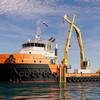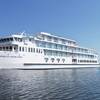When the Port of Toronto’s 45-year-old single screw tug, William Rest, got some hull damage while breaking ice, the incident lent new impetus to plans for a new boat. Like the original, the new boat would do a variety of tasks from tending to dredging, and icebreaking as well as assisting the Toronto Police and Toronto Fire Service marine units. Ports Toronto issued a call for tenders with a budget and set of requirements. Well know Ontario-based builder Hike Metals, approached the Vancouver-based naval architect firm of Robert Allan Ltd for a design. It was this design that helped Hike win the bid.
It was specified that this boat, like its predecessor, should have a single engine. While the older boat was not designed to break ice, the new one will have ice-breaking capabilities. With an overall length of 19.8 meters and, as a single screw tug, a beam of only 6.4 meters the design had to accomplish a variety of tasks.
Although ice breaking will only occupy the new vessel for a part of the year, its consideration contributed some interesting details to the design. Robert Allan harbor tugs have a distinctive stern shape that gives then good performance in reverse. However that same taper could force ice to go under the hull and possibly damage the rudder. To prevent this, an “ice knife” has been added midships below the transom. This will effectively cut any ice and push it to either side. As some ice may reach the 54-inch (1.35-meter) five-blade propeller, it has been designed with the extra blade thickness carried out to the tips for additional strength.
Modifications to the bow are more significant. In addition to heavier, more closely spaced scantlings, the bow is designed with a cut away starting at the waterline and angling aft. This allows the boat to ride up on the ice. However, unlike a dedicated icebreaker, the shape of the bow is left narrow to provide efficient passage through the water in the many months that the tug will not be functioning as an icebreaker. This, in turn, gave the designers another challenge as the beamier bow on a conventional ice breaker also provides stability when riding up on the ice, the narrow bow would not provide the same lateral support. To safeguard against the boat riding too high on the ice and tipping or also pushing the stern under water, the design includes an ice stopper, a sort of skeg, set well back and under the bow.
The single engine propulsion for the new tug will be an inline six-cylinder Tier 3 rated Cummins QSK19-M producing 750 HP providing six-tons of bollard pull.
Hans Muhlert of Robert Allan Ltd. explained that the firm chose the ABS Ice Class C0 standard to meet the ice breaking requirement, “This will allow the boat to break six-inch ice continuously and up to ten inches of ice by ramming and riding up on the ice.”
The tug, named in a competition by Toronto school children, Iron Guppy will carry the distinctive Robert Allan style wheelhouse structure that has been proven to provide excellent 360-degree visibility. As a day boat, it has no sleeping accommodations but does have a comfortable and spacious crew lounge and pantry. A knuckle boom crane is mounted aft of the deckhouse with a tow hook aft of that.










